Blog
Announcing Lumina: The purpose-built AI suite for PR, Comms, and Public Affairs
An intelligent suite of AI tools trained on the language, workflows, and realities of modern public relations and communications.
During a time of high interest rates and restrained spending, Buy Now, Pay Later (BNPL) is offering another avenue for consumers to cope financially.
In this environment individual approaches to finances are shifting with a growing number utilising BNPL for essentials rather than luxuries. As a result, attitudes towards spending are also evolving.
There are increased calls for regulation and scrutiny of the sector, with proposals for oversight similar to that of traditional credit cards. For brands even tangentially involved in the sector, and the PR & Comms professionals in situ, understanding what messaging resonates, where risk lies and how trust might be earned is essential.
Gain data-backed perspective on the communities engaging with the BNPL sector – from Gen-Z to political followers and fintech enthusiasts – and go beyond surface insights to understand their evolving preferences, concerns, and the implications for future financial behaviours.
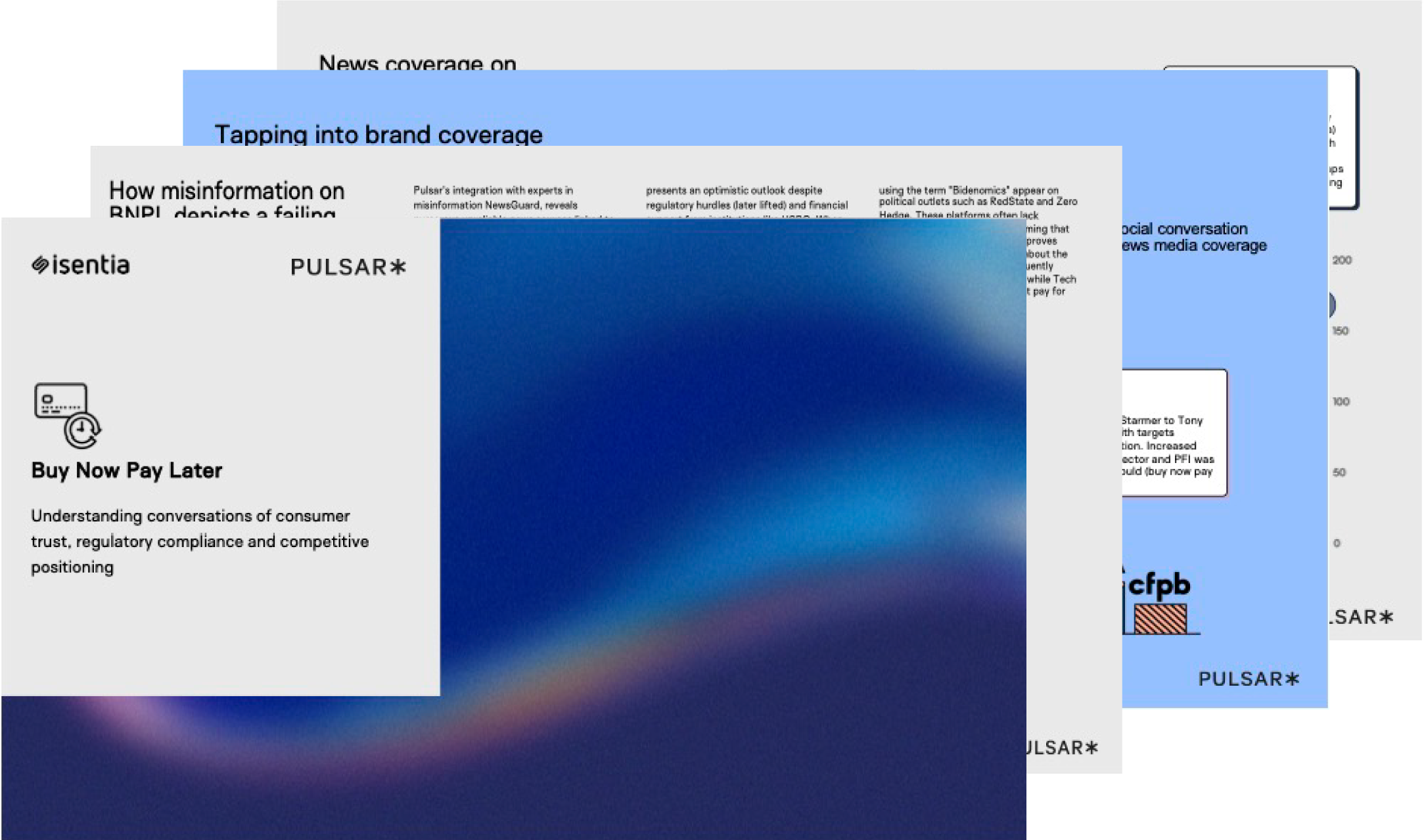
Loren is an experienced marketing professional who translates data and insights using Isentia solutions into trends and research, bringing clients closer to the benefits of audience intelligence. Loren thrives on introducing the groundbreaking ways in which data and insights can help a brand or organisation, enabling them to exceed their strategic objectives and goals.
The media landscape is accelerating. In an era where influence is ephemeral and every angle demands instant comprehension, PR and communications professionals require more than generic technology—they need intelligence engineered for their specific challenges.
Isentia is proud to introduce Lumina, a groundbreaking suite of intelligent AI tools. Lumina has been trained from the ground up on the complex workflows and realities of modern communications and public affairs. It is explicitly designed to shift professionals from passive media monitoring back into the role of strategic leaders and pacesetters.
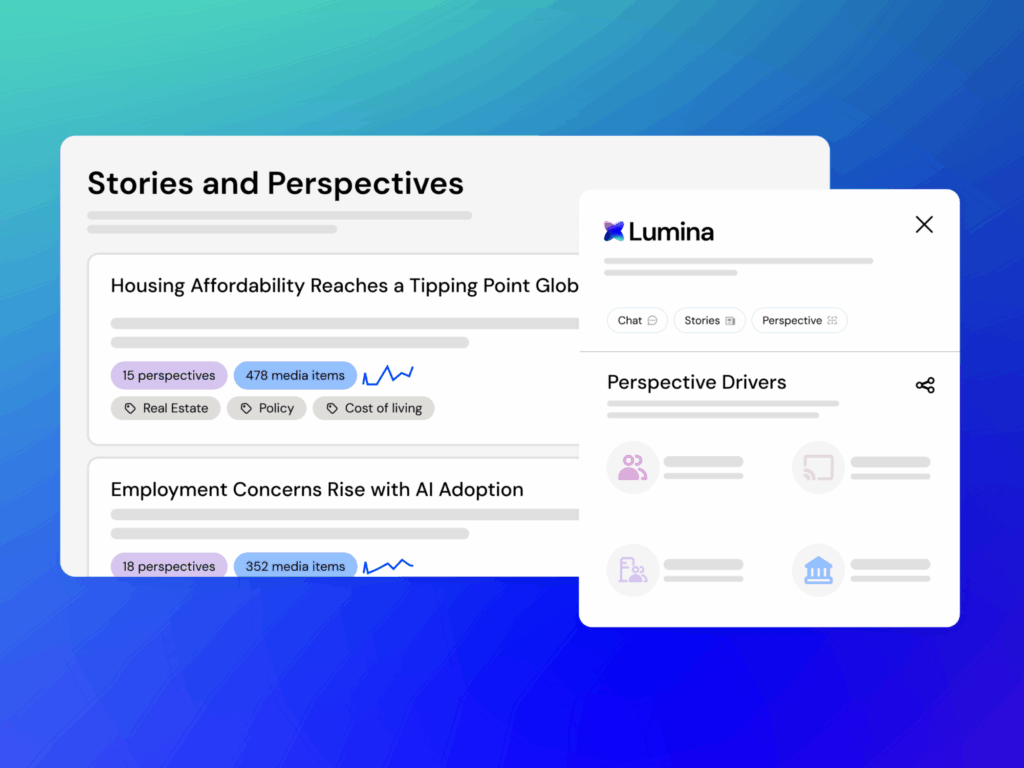
“The PR, Comms and Public Affairs sectors have been experimenting with AI, but most tools have not been built with their real challenges in mind.” said Joanna Arnold, CEO of Pulsar Group.
“Lumina is different; it is the first intelligence suite designed around how narratives actually form today, combining human credibility signals with machine-level analysis. It helps teams understand how stories evolve, filter out noise and respond with context and confidence to crises and opportunities.”
Lumina is centered on empowering, not replacing, the human element of communications strategy. This suite is purpose-built to help PR, Comms, and Public Affairs professionals significantly improve productivity, enhance message clarity, and facilitate early risk detection.
Lumina enables communicators to:
We are launching the Lumina suite by making our first module immediately available: Stories & Perspectives.
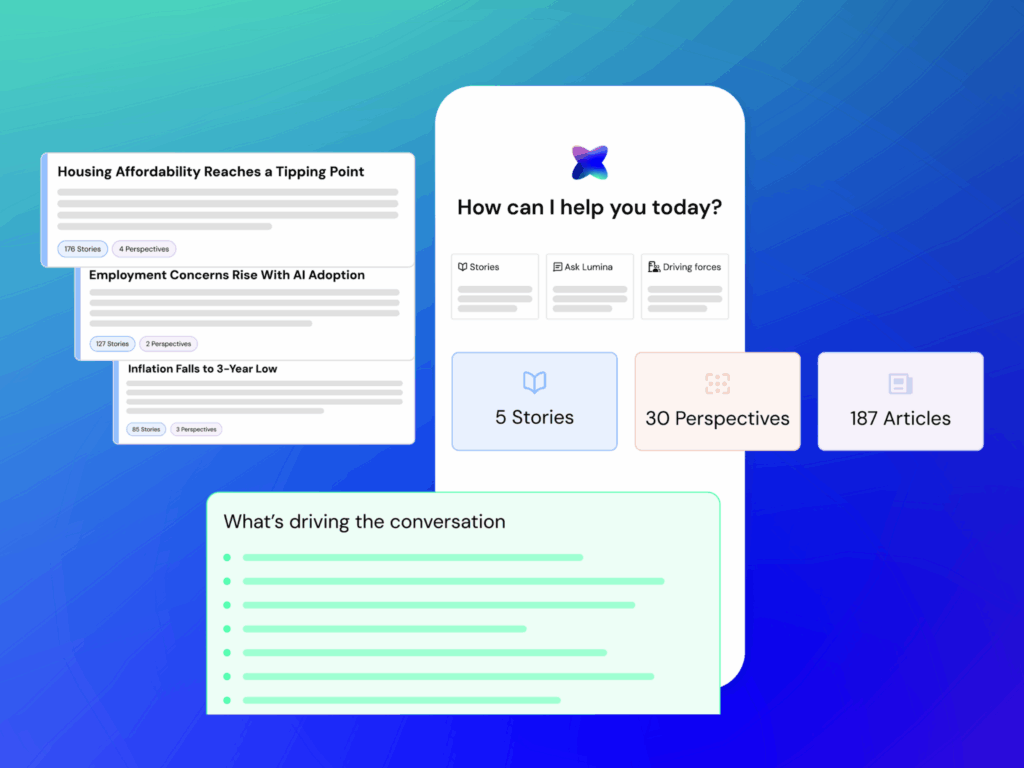
In the current fragmented, multi-channel media environment, communications professionals need to be able to instantly perceive not just how a story is growing, but also how it is being perceived across different stakeholder groups.
Stories & Perspectives organizes raw media mentions into clustered, cohesive Stories, and the Perspectives that exist within each, reflecting distinct media, audience, and public affairs angles. This unique functionality allows users to:
"Media isn’t a stream of mentions," said Kyle Lindsay, Head of Product at Pulsar Group. "But rather a living system of stories shaped by competing perspectives. When you can see those structures clearly, you gain the ability to understand issues as they form, anticipate how they’ll evolve, and act with precision. That’s what we mean when we talk about AI built for communicators, and that's what an off-the-shelf LLM can't give you."
The launch of Stories & Perspectives is the first release of many. Over the upcoming months, we will systematically roll out the full Lumina roadmap, introducing a comprehensive set of AI tools engineered to handle every phase of the communications lifecycle.
The full Lumina suite will soon incorporate:
Want to harness the power of Lumina AI for your PR, Comms, or Public Affairs team? .
Complete the form below to register your interest.
An intelligent suite of AI tools trained on the language, workflows, and realities of modern public relations and communications.
In a post-AI world where misinformation spreads faster than facts, trust in leadership has hit an all-time low. According to the latest Edelman Trust Barometer, we are witnessing a steep decline in how much the public trusts CEOs and institutions. So, how do leaders rebuild that capital?
In a recent webinar hosted by Isentia, we explored the critical role of authenticity as the pathway to trust. Moderated by Paik San, Head of Insights (Malaysia & Emerging Markets) at Isentia, the panel featured Kim Dy, Head of Brand & Communications for UnionDigital Bank, and Malathi Pillay, Director of Brand Equity & Communications at Malaysia Rapid Transit Corporation Sdn Bhd. Together with Isentia’s Prashant Saxena, VP, Revenue and Insights, SEA they unpacked how brands can navigate a low-trust environment by being human, consistent, and genuinely empathetic.

Here are the key takeaways from the discussion.
Prashant Saxena kicked off the session by grounding the abstract concept of trust in a practical framework. He noted that while trust is the ultimate "wealth" a brand possesses—protecting it during crises, authenticity is the daily "currency" one must invest to build that wealth.
Isentia’s data suggests that many leaders suffer from an "Authenticity signal poverty"—posting content that lacks social proof, information credibility, or cultural fit. To combat this, communication must rely on the "Three Ps":
One of the most powerful insights came from Malathi Pillay at MRT Corp, who manages the reputation of massive public infrastructure projects, emphasized that trust isn't built in big moments, but through the consistency of day-to-day behavior. Her advice for staying authentic is to avoid the trap of "motherhood statements", words that don't really resonate with the common audiences.
She explained that stating a vision like "transforming mobility" is often lost on the audience. To make the brand promise authenticity, one must provide context.
"We always try to support our messaging with specific examples... We talk about that university student that lives in Kajang, who is now able to get to his university in Kota Damansara in one smooth ride within 45 minutes." — Malathi Pillay.
By grounding the narrative in specific, relatable human benefits, like saving time or creating local jobs, brands can bridge the gap between corporate goals and public reality. She also mentions how misinformation does not always have to be dealt with bold statements. Quiet corrections also go a long way in maintaining consistency in our media comms.
Kim Dy from UnionDigital Bank addressed the challenge of humanising a traditionally cold and intimidating industry: banking. For a digital bank where customers may never speak to a human, the brand voice must do the heavy lifting.
Kim introduced the idea of a "human compass"—a framework ensuring every notification, app interface, and social post is helpful, clear, and optimistic.
"People trust people, not logos. Authenticity means speaking the language of your customers, and staying away from jargon in an industry that is unwelcoming and very intimidating." — Kim Dy
She shared a real-world example where a deepfake of a brand ambassador surfaced promoting gambling. Instead of hiding, the bank acted with speed and transparency, proving that trust isn't built in good times alone, but is earned by how you face problems head-on and when audiences actually see the steps taken to better the brand's reputation and earn back trust.
Both panelists agreed that the role of a leader has shifted. In the past, authority meant firmness. Today, authority requires empathy.
As the panel concluded, the conversation turned to the role of AI.
Prashant highlighted a "speed vs. sincerity" dilemma facing modern communicators. His solution was to let data provide the authority, but let leadership provide the empathy. Malathi added that while AI is a tool we all use, leaders must have the discipline not to let it replace human judgment.
In her closing remarks, Paik San summarises that the secret to building lasting trust is coherence. It is the alignment of what you say, what you do, and how you make your audience feel over time.
Whether you are managing a digital bank or the infrastructural capabilities of public transport, the rules of engagement have changed. In a noisy world, the most cutting-edge strategy a leader can employ is simply being human.
Interested in viewing the whole recording? Watch our webinar here.
Alternatively contact our team to learn more insights into authenticity, leadership and why trust is on a decline.
The webinar explores how leaders can rebuild eroding public trust by treating authenticity as currency through transparent communication.
In leadership meetings across the industry, a single question has become unavoidable: "What is our AI strategy?" Behind this question is often the unspoken hope for an "AI Easy Button": a mythical, one-click solution to our most complex measurement challenges. As someone who spends a large portion of my time designing these new frameworks, I'm infinitely more excited about the blueprints and the foundations than what colour the house is painted.
For the first time in my career, we have the tools to stop using proxies and start building what we've always wanted: true, at-scale, sophisticated measurement. The real opportunity isn't in automation, which lets the AI decide; it's in the architecture and design of systems for the AI to follow. For decades, I’ve been frustrated by proxies. I’ve watched organisations use metrics like Impressions and Share of Voice as proxies for impact and influence. Too many people have been measuring the loudness of their voice, not whether anyone was actually listening.
Much of the history of communications measurement has been a story of 'good enough' data. And in some cases, data that wasn't even good at all (*cough* AVEs).
But before we can harness the potential of AI, we have to be honest about the technology and tools we're working with. As anyone who's ever used a "smart" tool knows, they can be... well, confidently wrong.
The new challenge isn't just "Garbage In, Garbage Out." The new challenge is that the AI has become a high-speed, frighteningly convincing echo chamber. When a machine delivers a flawed insight, it does so with the resolute certainty of a supercomputer, laundering that flaw into a "fact."As architects, our job is to audit the blueprints and stress-test the materials before we build the house. When my team and I test these models, we're not just looking for what they do right. We're methodically hunting for where they go wrong.
Where we continue to see a critical need for human intervention and expertise:
This is the methodical, behind-the-scenes work that often goes unseen, and it is the crucial due diligence needed. It’s not as flashy as writing a press release faster, but it’s the only way to build a tool you can actually trust to make a strategic decision.
This testing isn't just about finding technical bugs or funny hallucinations. We’re testing these new AI models against the foundational, hard-won principles of communications measurement that our industry has spent years formalising.
AI is an incredibly powerful new tool, but it doesn't get a free pass. It still has to follow the rules of good measurement.
When we stop seeing AI as a magic box and start seeing it as a powerful, scalable engine, one that we must build and steer based on these principles, then it becomes truly transformative.
A new frontier of opportunity is here. Such as the capability to move from being reactive to being predictive, and it takes careful design to get this right. Our traditional analysis has been brilliant at explaining what has just happened. Now, as architects of these new systems, we are building and testing AI models that can scan the horizon for the faint signals that precede a major narrative shift.
We can empower movement from broadcasting and the old spray and pray approach; to precision, deliberate engagement of stakeholders and audiences. This is another area where the craft of measurement design is essential. AI gives us the power to see the micro-communities and specific, high-authority voices that actually shape opinion. The work is in designing the models that can identify them accurately.
Finally, we can (at last!) move from quantifying to qualifying at scale. For me, this is the most exciting and complex challenge. For 20 years, I’ve had to choose: a large-scale quantitative study (which missed nuance) or a small-scale qualitative review (which couldn't be scaled). As architects, we can now design frameworks that don't just give a "positive" score but confirm that a specific strategic message landed, with the right audiences, and in the intended context.
That is the opportunity. It's not magic. It's the methodical, patient engineering we've been waiting for. It’s the difference between a "plug-and-play" gimmick and a truly strategic asset. The real payoff isn't just faster reporting, it’s about fundamentally upgrading behaviours and expectations of measurement. This isn't an overnight shift. As any research leader will tell you, a new methodology takes time, testing and refinement to get right.
For my entire career, we’ve been strategic thinkers working with tools that could only show us the past. We were forced to be historians, meticulously analysing what had already happened to predict future behaviour. The key to using this new, complex technology effectively is; strong communication, articulation and critical human thinking. The power of any AI is unlocked by the quality of the question you ask it. It's a system that rewards clear, precise, and strategic language.
This is a massive homefield advantage for communicators, who have spent their entire careers honing the exact skills required to be the architects of this new era. The AI we are using today is the worst it will ever be. It will only get better, faster, and more capable from here. This is what's so thrilling, and it's just the beginning. This new generation of AI driven approaches doesn't replace our intuition, it amplifies it. As communicators (and researchers!) this is the moment to level up. We get to be the explorers and the strategists who connect communications directly to business, policy and societal outcomes.
We're not just building better measurement and deeper insights; we're leading a more intelligent, more responsive and more impactful profession. What an incredibly exciting time to be in this industry.

To learn how to build the right KPIs and tell a compelling story with your data, register for our live webinar:
Explore how crucial human oversight is over AI models when it comes to the future of smart measurement in communications.
The global landscape of Muslim travel has fundamentally changed in the post-pandemic era. We are no longer talking about a niche market but about a dynamic, rapidly expanding demographic reshaping global tourism. We recently worked on a co-branded report with Have Halal, Will Travel (HHWT), which included an analysis of 1.4 million data points on mainstream and social media sources in the APAC region from 1st November 2024 - 31st August 2025 to a significant shift in modern travel. Asia has emerged as the new epicentre for travel conversations, surpassing the Middle East. As countries seek to attract this market for economic growth, especially amid declining tourism from other regions, the space has become crowded. For brands and destinations looking to capitalise on the right audiences, superficial efforts are no longer enough. Being authentic is the crucial currency in this new world.

Prashant Saxena, VP of Revenue and Insights, for the SEA region presented this report at the Have Halal, Will Travel Deep Dive session on "Brave New World" that saw PR & Comms and marketing folks from airlines, hotels and tourism boards interested to understand what the latest travel insights are and why Muslim travel is surging. We interacted with the attendees at our booth to introduce them to our media monitoring and audience intelligence capabilities.

Destinations and brands are "walking the talk" by moving beyond marketing campaigns to tangible, on-the-ground investment. Nations are actively developing Muslim-friendly infrastructure, including airlines, hotels, and payment platforms, to cater to this influx of travelers. This does not mean providing only basic services, but rather aiming to be as culturally inclusive as possible by embedding Muslim-friendly considerations into the travel experience. This is also in part exacerbated by the decline in Chinese travellers to Southeast Asia, which has led to nations in this region attracting Muslim tourists and looking at them as the best option, seeing how much of a muslim crowd there already is domestically.
For example, Vietnam is building a comprehensive Halal tourism ecosystem with the goal of establishing Muslim-friendly zones in its capital by 2030. Similarly, the Philippines has rolled out halal-accredited establishments and essential services like healthcare and finance , while Australia is mainstreaming halal food alongside other ethical/lifestyle choices like 'vegan' and 'gluten-free'. This changes the narrative, showing a deep commitment that resonates far more powerfully than a simple welcome.

The necessity is for brands and tourism destinations to take control of the story, even when there are issues. The opportunity is immense, but travellers are acutely aware of challenges. Conversations around rising costs and scams have dominated online discussions, particularly in Southeast Asia. Countries like Malaysia and Turkey have seen negative sentiment due to issues with halal certification and travel scams, which erode trust at a foundational level. In Indonesia, some even link inflation to the regulatory burdens of halal certification on small businesses.
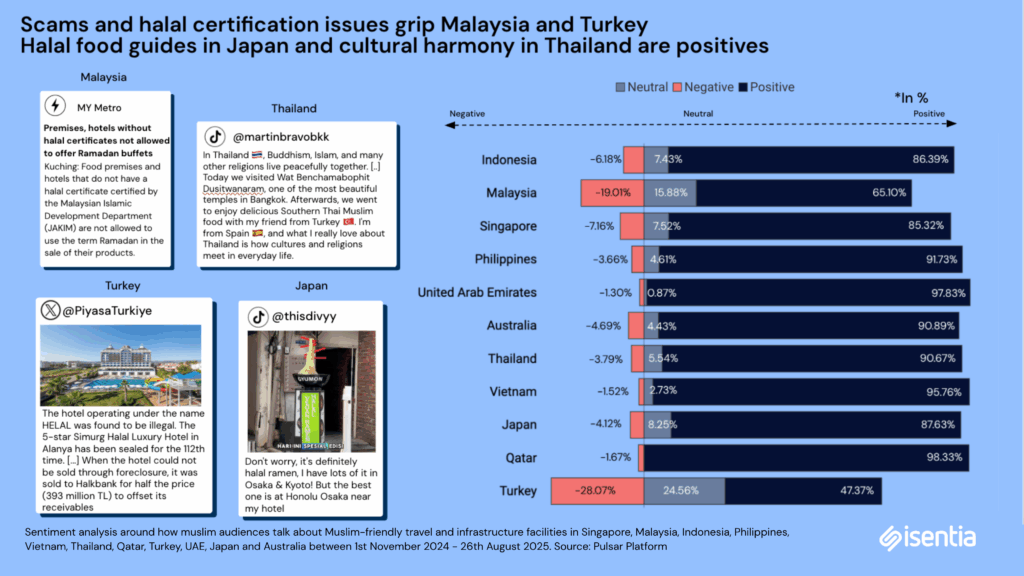
The best way for brands and tourism groups to address these concerns is to clearly explain what they are doing to fix them. Admitting there are problems shows responsibility and helps build trust by proving they listen to travelers. Technology, like apps for faith-based services, is helpful, but it is not enough on its own. They must be backed by transparent action on the ground.

Brands need to understand that in an increasingly digital world, audiences are highly alert to signals of what feels "real". The report introduces an "authenticity playbook" that outlines key cues that shape whether audiences trust and engage with content. The analysis shows that social media posts with more authenticity cues or signals have higher engagement rates.
To make the most of this, brands should create strategies that are both efficient and focus on the human qualities people care about. Communication from brands or leaders should include:
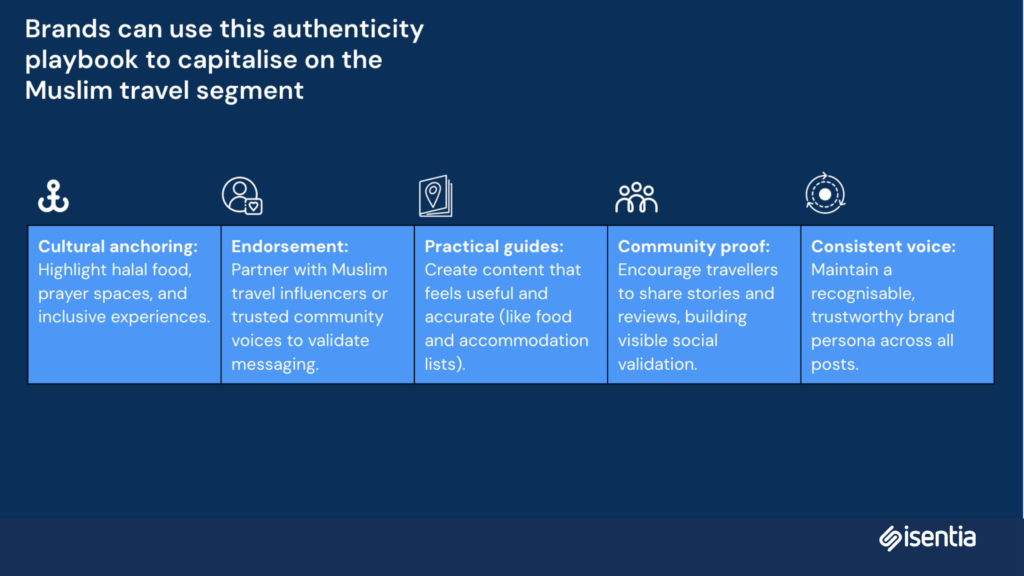
The Muslim travel market is evolving with sophistication and purpose. Travellers today are looking for more than just halal food options. They are seeking digital detox retreats inspired by Islamic values, regenerative tourism that supports local communities, and safe spaces for solo female travelers. For destinations and brands, the path forward requires an authentic and strategic commitment. The ones that master the art of genuine connection and consistently "walk the talk" will not only capture a share of this thriving market but will also earn its most valuable asset: trust.
Interested in learning how Isentia can help? Fill in your details below to get access to our latest co-branded report on "Muslim Travel Pulse: evolving audience perception on Muslim food, travel and trade" and read more about our cues designed to measure brand authenticity.
Get in touch or request a demo.